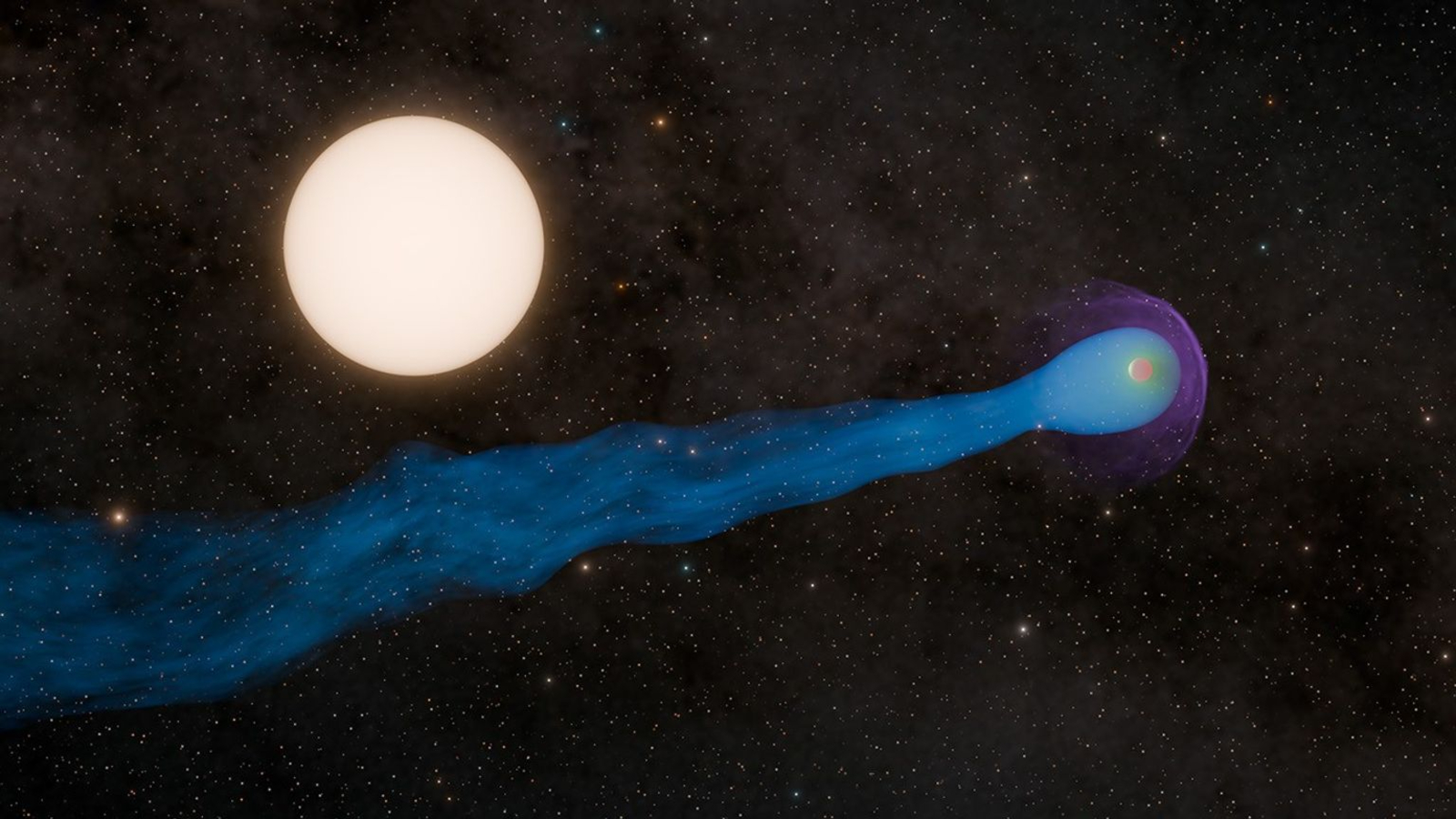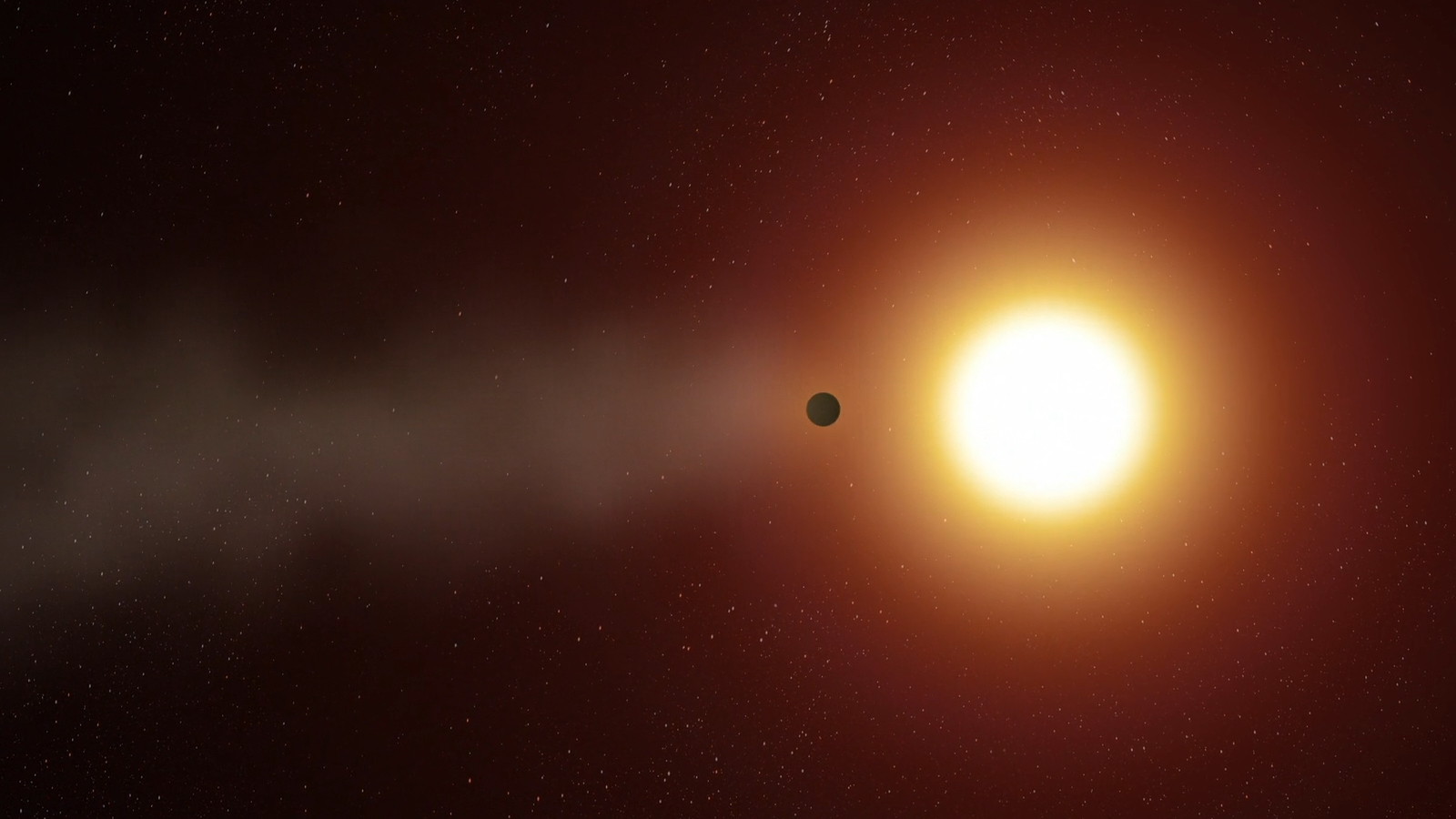Nearby exoplanet has grown a tail 44 times longer than Earth — and it's acting like a giant 'stellar windsock'
Researchers have detected a giant tail of gas leaking from an exoplanet near Earth. The giant structure, which is up to 350,000 miles long, is being blown away from the alien world by stellar gusts, allowing researchers to use it like a windsock.

An alien world near Earth is being trailed by a gigantic tail, stretching longer than 40 Earths as it closely circles its home star. The enormous structure, which is made up of gas leaking from the exoplanet's atmosphere, is being blown by stellar winds like a giant "windsock," experts say.
The exoplanet, WASP-69 b, is a gas giant. It's around the same size as Jupiter but less than a third as massive, and orbits a main sequence star roughly 160 light-years from Earth. It is very close to its star, completing a single trip around the alien sun every 3.9 days.
Since its discovery in 2014, researchers have noticed that WASP-69 b is losing up to 200,000 tons (180,000 metric tons) of mostly helium and some hydrogen gas per second, which is likely being lost as a result of it being superheated by the exoplanet's star. At this rate, the exoplanet has likely lost up to seven Earth masses during its lifetime, which has lasted around 7 billion years.
Scientists previously speculated that WASP-69 b might have a comet-like tail made up of some of the gas it leaks into space, but this had never been confirmed. However, in a study published Jan. 9 in the journal Astronomy and Astrophysics, researchers analyzed the alien world using data from the W. M. Keck Observatory on Maunakea, Hawaii to precisely measure the planet and its surroundings, and found that it really did have a tail that stretches up to 350,000 miles (560,000 kilometers) long — roughly 44 times as long as Earth is wide.
"Previous observations suggested that WASP-69 b had a modest tail, or no tail at all," study lead author Dakotah Tyler, an doctoral candidate in astrophysics at UCLA, said in a statement released at the time. "However, we have been able to definitively show that this planet's helium tail extends at least seven times the radius of the giant [exo]planet itself."
Related: 32 alien planets that really exist

WASP-69 b's tail forms when "stellar wind" blows the leaking gas away from the exoplanet, creating a trail in its wake. Stellar wind, similar to the sun's solar wind, is a stream of charged particles that are constantly being spat out by the star. If the stellar wind were to disappear, then the tail would also fade away, researchers wrote.
Sign up for the Live Science daily newsletter now
Get the world’s most fascinating discoveries delivered straight to your inbox.
"If the stellar wind were to taper down, then you could imagine that the planet is still losing some of its atmosphere, but it just isn't getting shaped into the tail," Tyler said in a new NASA statement released Dec. 10. Without the stellar wind, that gas escaping on all sides of the planet would be spherical and symmetrical, he said. "But if you crank up the stellar wind, that atmosphere then gets sculpted into a tail."
The discovery could help us learn more about how gas giants form and evolve over time, and also provides scientists with a rare opportunity to measure the stellar winds of distant stars by using the tail like a giant "windsock," NASA representatives wrote in the statement.
"These comet-like tails are really valuable because they form when the escaping atmosphere of the planet rams into the stellar wind, which causes the gas to be swept back," study co-author Erik Petigura, a professor of physics and astronomy at UCLA, said in the earlier statement. "Observing such an extended tail allows us to study these interactions in great detail."

Harry is a U.K.-based senior staff writer at Live Science. He studied marine biology at the University of Exeter before training to become a journalist. He covers a wide range of topics including space exploration, planetary science, space weather, climate change, animal behavior and paleontology. His recent work on the solar maximum won "best space submission" at the 2024 Aerospace Media Awards and was shortlisted in the "top scoop" category at the NCTJ Awards for Excellence in 2023. He also writes Live Science's weekly Earth from space series.










